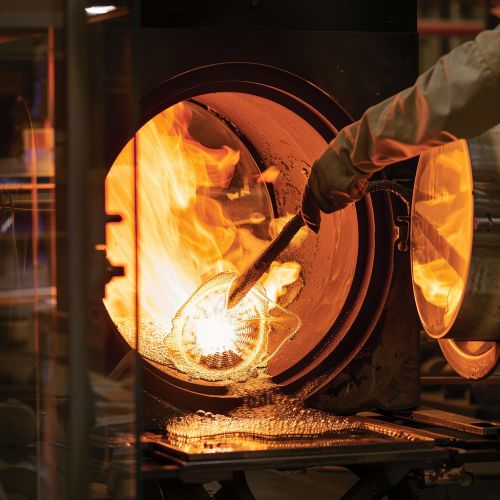Vitrification: Difference between revisions
(Created page with "== Introduction == '''Vitrification''' is the process of transforming a material into a glass-like amorphous solid that is free of any crystalline structure. This process can occur naturally, such as in the formation of obsidian, or can be induced artificially through various techniques. Vitrification is a significant concept in multiple scientific and industrial fields, including materials science, cryopreservation, and waste management. == Principles of Vitrifica...") |
No edit summary |
||
| Line 27: | Line 27: | ||
Melt quenching is the most common technique for vitrification, involving the rapid cooling of a molten material. This method is widely used in the production of commercial glasses. The cooling rate must be sufficiently high to prevent the formation of crystalline phases. Factors such as the composition of the material and the cooling medium play a crucial role in the success of melt quenching. | Melt quenching is the most common technique for vitrification, involving the rapid cooling of a molten material. This method is widely used in the production of commercial glasses. The cooling rate must be sufficiently high to prevent the formation of crystalline phases. Factors such as the composition of the material and the cooling medium play a crucial role in the success of melt quenching. | ||
[[Image:Detail-92395.jpg|thumb|center|A glass furnace with molten glass being handled by a worker.|class=only_on_mobile]] | |||
[[Image:Detail-92396.jpg|thumb|center|A glass furnace with molten glass being handled by a worker.|class=only_on_desktop]] | |||
=== Sol-Gel Processing === | === Sol-Gel Processing === | ||
Latest revision as of 23:38, 14 June 2024
Introduction
Vitrification is the process of transforming a material into a glass-like amorphous solid that is free of any crystalline structure. This process can occur naturally, such as in the formation of obsidian, or can be induced artificially through various techniques. Vitrification is a significant concept in multiple scientific and industrial fields, including materials science, cryopreservation, and waste management.
Principles of Vitrification
Vitrification involves the rapid cooling of a liquid to bypass the crystallization process, resulting in a glassy state. The key to achieving vitrification is to cool the material quickly enough to avoid the nucleation and growth of crystals. This rapid cooling is often referred to as "quenching." The glass transition temperature (Tg) is a critical parameter in vitrification, representing the temperature below which the material behaves as a glassy solid.
Applications of Vitrification
Materials Science
In materials science, vitrification is used to create glasses and glass-ceramics with specific properties. For example, borosilicate glass is known for its low thermal expansion and high chemical resistance, making it ideal for laboratory glassware and cookware. The process of vitrification can also be used to produce metallic glasses, which exhibit unique mechanical properties such as high strength and elasticity.
Cryopreservation
Vitrification is a crucial technique in cryopreservation, where biological samples such as cells, tissues, and organs are preserved at extremely low temperatures. Traditional cryopreservation methods often lead to the formation of ice crystals, which can damage cellular structures. Vitrification, on the other hand, prevents ice crystal formation by transforming the water within the biological material into a glass-like state. This technique is widely used in reproductive medicine for the preservation of oocytes and embryos.
Waste Management
In the field of waste management, vitrification is employed to immobilize hazardous and radioactive waste. The waste material is mixed with glass-forming additives and heated to high temperatures until it melts. The molten mixture is then cooled rapidly to form a stable, glassy solid. This vitrified waste form is highly durable and resistant to leaching, making it suitable for long-term storage and disposal.
Vitrification Techniques
Melt Quenching
Melt quenching is the most common technique for vitrification, involving the rapid cooling of a molten material. This method is widely used in the production of commercial glasses. The cooling rate must be sufficiently high to prevent the formation of crystalline phases. Factors such as the composition of the material and the cooling medium play a crucial role in the success of melt quenching.


Sol-Gel Processing
Sol-gel processing is a chemical method used to produce glassy materials at relatively low temperatures. In this process, a sol (a colloidal suspension of particles) is transformed into a gel (a network of interconnected particles). The gel is then dried and heated to remove any remaining solvent, resulting in a glassy material. Sol-gel processing is particularly useful for producing thin films and coatings.
Laser Vitrification
Laser vitrification involves the use of high-intensity laser beams to rapidly heat and cool a material, inducing vitrification. This technique is advantageous for its precision and ability to vitrify localized regions of a material. Laser vitrification is used in various applications, including the fabrication of microelectronic devices and the repair of damaged glass components.
Challenges and Limitations
While vitrification offers numerous advantages, it also presents several challenges and limitations. One of the primary challenges is achieving a sufficiently high cooling rate to prevent crystallization. This is particularly difficult for large or complex-shaped objects. Additionally, the thermal stresses induced during rapid cooling can lead to cracking and other defects in the vitrified material.
In cryopreservation, the high concentrations of cryoprotectants required for vitrification can be toxic to biological samples. Researchers are continually exploring new cryoprotectants and techniques to mitigate these effects.
Future Directions
The field of vitrification is continually evolving, with ongoing research aimed at overcoming current limitations and expanding its applications. Advances in materials science are leading to the development of new glass-forming compositions with improved properties. In cryopreservation, novel cryoprotectants and vitrification protocols are being investigated to enhance the viability of preserved biological samples.
In waste management, researchers are exploring the use of vitrification for the immobilization of a broader range of hazardous materials. The development of more efficient and cost-effective vitrification technologies is also a key area of focus.
